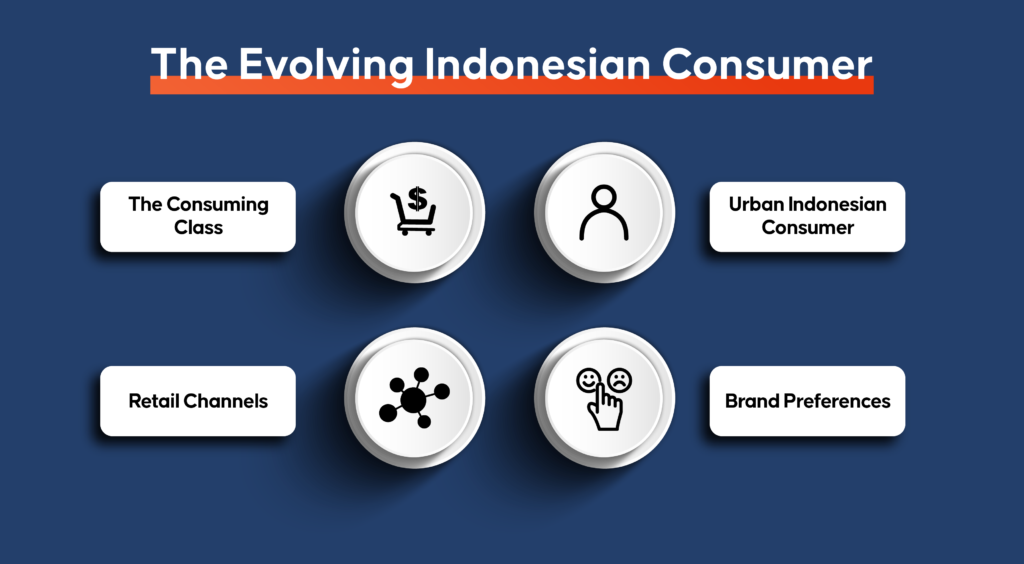Inquivix HQ
1-903, 18 Eonju-ro 146-gil,
Gangnam-gu, Seoul, Korea
06057

The Indonesian market insight is a potential market that has a lot of opportunities for businesses to explore. The Indonesian market has a population of over 260 million people and is the world’s fourth most populated country. Located on the world’s major trade routes, it is also the largest economy in Southeast Asia and is projected to be one of the world’s fastest-growing economies over the next decade. Due to its extensive natural resource wealth, the Indonesian economy continues to grow with significant regional autonomy.
This blog post will give you a complete insight into the Indonesian market, including its history, demographics, and economy. We will also discuss some of the challenges that businesses face when entering this market, as well as some tips on how to overcome them. So if you’re interested in doing business in Indonesia, make sure to read this post!
Why Select Indonesia for Business?
Indonesia is a great place for businesses to invest and grow. With an economy that has been projected to have a GDP growth at an average of 5% annually in 2022, Indonesia is Southeast Asia’s largest economy. Additionally, the country has a population of over 250 million people who are eager to consume goods and services. Infrastructure development is also progressing at a stable rate.

Indonesia has a younger workforce with an average age of around 30 years old, which is a positive for businesses that are looking to expand their operations. The growing economy has given the population increased purchasing power, which means that businesses have a better chance of growth. Furthermore, Indonesia welcomes foreign investment opportunities with its specialized economic zones.
These factors make Indonesia an attractive destination for businesses looking to expand into Southeast Asia. Additionally, the country offers a number of incentives for businesses including tax breaks and special economic zones. For these reasons, it is no surprise that Indonesia has been ranked as one of the top 20 economies in the world for ease of doing business.
Indonesian Market Overview
The Indonesian economy features strong social stability, robust domestic demand for goods and services, steadily rising foreign reserves (just under $136 billion in May 2021), and stable prices with moderate-to-low inflation. The central government of Indonesia continues to improve the investment climate expecting to harness the opportunities Indonesia has due to its strategic location.
However, persistent trade and investment barriers are driven by protectionist sentiments, unequal infrastructure, inconsistent legal interpretation, and enforcement, and labor rigidity continue to impede greater levels of economic growth. Nonetheless, Indonesian GDP is expected to grow at a five-percentage-point annual rate in 2021–2025, driven primarily by private consumption and investment. The government has been taking measures to improve the business environment, including through a series of deregulation packages and initiatives to improve the poor infrastructure.
Market Challenges in Indonesia
Despite the consistent economic growth and policy reforms, the Indonesian market does have its challenges. There are several challenges that must be overcome in order to do business in Indonesia. Among various minor issues, challenges related to labor relations, intellectual property protection, legal transparency, standardization and certification, and pricing are all significant issues.
There are several employment-related issues, such as severance pay, the minimum wage, job security, and social benefits. Another element to consider for foreign direct investment in Indonesian immigration rules. In the absence of labor market deregulation and measures to curb foreign workers in Indonesia, foreign investors will face difficulties recruiting, paying, and retaining the most suitable employees. Furthermore, local content requirements, which have originally been focused solely on the oil and gas sector, are now being applied to a wider range of economic sectors. Foreign investors may now be required to source more than 75% of their supplies locally, which is a problem in a market where there are few advanced manufacturing capabilities.
Indonesia’s intellectual property laws continue to hinder foreign investment. Businesses trying to enter the market should be aware of widespread Copywrite violations and the lack of patent protection. Another challenge a foreign business would face is the testing and certification requirements for products before they enter the Indonesian market. These can be onerous and time-consuming, and add to the cost of doing business in Indonesia.
Indonesian Market Opportunities

Indonesia is a rapidly growing economy with strong domestic demand and a large population. There are many opportunities in the Indonesian market for businesses that can capitalize on the country’s economic development. Domestic consumption is a key driver of economic growth in Indonesia, so businesses that focus on selling products and services to Indonesian consumers will be successful. Consumers in Indonesia are recognized as some of the most confident in the world, and around 41% of Indonesians live under the age of 25.
Indonesia’s developing public infrastructures, such as roads and ports, provide numerous possibilities for aviation, rail, shipping, and land transportation. The growing financial sector has also opened up opportunities in the IT, software, technology, and telecommunications industries. Because development in rural areas is a top government priority, there is strong demand for conventional and renewable energy sources. Education and medical fields continue to grow rapidly, presenting major market opportunities for investors in those sectors. Indonesia’s agriculture industry has opened up opportunities in the market for agricultural products as well.
Market Entry Strategy
Finding and working with local partners to market their products is frequently advised for foreign businesses attempting to enter the Indonesian market. When feasible, it’s critical that investors visit and meet with potential partners in person to conduct thorough research. It’s critical to take appointments with representatives cautiously since forming a new connection may be difficult.
Understanding Indonesian culture and local consumer preferences is critical for success. There are three key ingredients for success in the Indonesian market: patience, tenacity, and presence. Indonesian customers are price-conscious, credit-constrained, tech-savvy, and demanding of excellent after-sales service. The following are some factors to consider when purchasing in Indonesia: pricing, financing, technical knowledge, and after-sales support. Firms must be ready to invest in employee training at every level, from entry-level to management.
The Evolving Indonesian Consumer
Today, Indonesia is a dynamic country with limitless potential. The nation’s growth rate has been one of the most consistent in the world over the past ten years, averaging almost 5 percent each year. It is also one of the world’s largest economies, with a GDP totaling USD 878 billion. Despite the fact that inflation has risen, and there has been stock market volatility and a weakening Rupiah, Indonesia’s long-term fundamentals—such as favorable demographics, high private spending, and fast urbanization—remain strong.
Indonesia is projected to account for nearly 40% of ASEAN’s expansion by 2030. The country’s young demographic—nearly 60% are under 30 years old—and its growing population of 2.9 million people each year are the driving factors behind the growth. Indonesia is urbanizing rapidly, which is fueling an increase in incomes and the ability for customers to spend on non-essential goods. Furthermore, it’s an economy that’s largely dependent on domestic spending—Indonesian consumers spent $57 billion last year, almost double what their regional counterparts spent.
The Consuming Class
Indonesia’s population is youthful, growing, and rapidly urbanizing, making it one of the world’s fastest-growing consumer markets. Our study of urban and rural populations revealed groups totaling about 70 million people who are confident in their future prospects and more sophisticated in their shopping behaviors and product selections. There are 15 million rural consumers who live in rural city clusters near big metropolitan areas, accounting for a third of all retail sales. These customers have comparable sentiments to people living in cities. Understanding the demands and emerging attitudes of this fast-developing market can reveal future business opportunities.
Urban Indonesian Consumer
From 2000 to 2013, Indonesia’s urban population rose from 42% to 55% or 138 million people. By 2030, the proportion is projected to rise to 71% or 209 million people. Urban Indonesia’s GDP contributions are expected to rise from 74% in 2010 to 86% by 2030, when measured in other terms, from USD 524 million to USD 1.7 billion. Indonesia’s cities will have a significant impact on the country’s economic development. There is the emergence of what we term “five hidden gem cities” in Indonesia. Despite their smaller populations, these cities indicate signs of promise, with higher disposable incomes and more favorable consumption habits.

Retail Channels
Although traditional retail channels, such as mom-and-pop stores and wet markets, continue to dominate the Indonesian retail industry, modern trade’s proportion is increasing because of the growth of convenience shops. As customers turn to numerous outlets—convenience stores, hypermarkets, supermarkets, department stores, etc.—the contemporary retail environment has become increasingly fractured. Though Indonesians are among the world’s most active users of social media platforms, commercial activities have a low penetration rate. Consumers expressed concerns about payment security, slow delivery times, and poor quality when it comes to online purchases.
Brand Preferences
Indonesians, on average, have a strong preference for local brands across most product categories. When it comes to buying a home and personal care goods, 75% of those polled said they already have a preferred brand in mind; this proportion rose to 80% when looking at food and beverage items. Consumers have a high level of confidence in Indonesian businesses, enjoy using local products, and believe that Indonesians get a better understanding of them than foreign companies and provide greater value for their money. However, it is significant to note that only the perception of being local matters; foreign businesses have dominated the market through localization or acquisition methods.
Conclusion
The Indonesian market, which is Southeast Asia’s largest economy, is a promising investment opportunity with great potential for growth. The country has a population of over 250 million people and a rapidly growing economy. With an increasing number of consumers entering the middle class, there are many opportunities for businesses to expand their operations in Indonesia. In order to capitalize on these opportunities, it is important to understand the unique characteristics of the Indonesian market. By understanding the market landscape and consumer preferences, businesses can create products and services that meet the needs of Indonesian consumers. We hope that this article gave you insight into one of the fastest-growing economies in the world.
